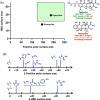Using permeation guidelines to design new antibiotics-A PASsagE into Pseudomonas aeruginosa
- PMID: 38426413
- PMCID: PMC10905542
- DOI: 10.1002/ctm2.1600
Using permeation guidelines to design new antibiotics-A PASsagE into Pseudomonas aeruginosa
Figures


Similar articles
-
[Role of antibiotics in infections due to Pseudomonas aeruginosa].Cesk Epidemiol Mikrobiol Imunol. 1972 Jul;21(4):176-81. Cesk Epidemiol Mikrobiol Imunol. 1972. PMID: 4262242 Czech. No abstract available.
-
[Sensitivity in vitro to antibiotics and chemotherapeutic agents in various hospital strains of Pseudomonas aeruginosa].Boll Ist Sieroter Milan. 1974 Jan-Feb;50(1):45-53. Boll Ist Sieroter Milan. 1974. PMID: 4204863 Italian. No abstract available.
-
[Trend of therapy in Pseudomonas aeruginosa infections].G Mal Infett Parassit. 1971 Nov;23(11):1051-4. G Mal Infett Parassit. 1971. PMID: 5004852 Italian. No abstract available.
-
Therapeutic approaches for combating Pseudomonas aeruginosa infections.Microbes Infect. 2022 Jun;24(4):104950. doi: 10.1016/j.micinf.2022.104950. Epub 2022 Feb 6. Microbes Infect. 2022. PMID: 35139390 Review.
-
Antibiotic selection in the treatment of acute invasive infections by Pseudomonas aeruginosa.Rev Esp Quimioter. 2019 Sep;32 Suppl 2(Suppl 2):32-34. Rev Esp Quimioter. 2019. PMID: 31475807 Free PMC article. Review.
Cited by
-
Deciphering Chemical Rules for Drug Penetration into Strongyloides.Pharmaceutics. 2024 Sep 19;16(9):1224. doi: 10.3390/pharmaceutics16091224. Pharmaceutics. 2024. PMID: 39339260 Free PMC article.
-
From Bones to Bugs: Structure-Based Development of Raloxifene-Derived Pathoblockers That Inhibit Pyocyanin Production in Pseudomonas aeruginosa.J Med Chem. 2025 Apr 10;68(7):7390-7420. doi: 10.1021/acs.jmedchem.4c03065. Epub 2025 Mar 29. J Med Chem. 2025. PMID: 40156840 Free PMC article.
-
Advances in methods and concepts provide new insight into antibiotic fluxes across the bacterial membrane.Commun Biol. 2024 Nov 14;7(1):1508. doi: 10.1038/s42003-024-07168-4. Commun Biol. 2024. PMID: 39543341 Free PMC article.
-
Identification of chemical features that influence mycomembrane permeation and antitubercular activity.bioRxiv [Preprint]. 2025 Feb 27:2025.02.27.640664. doi: 10.1101/2025.02.27.640664. bioRxiv. 2025. PMID: 40060676 Free PMC article. Preprint.
-
Identification of a Selective Anticancer Agent from a Collection of Complex-And-Diverse Compounds Synthesized from Stevioside.J Am Chem Soc. 2025 Mar 26;147(12):10647-10661. doi: 10.1021/jacs.5c00919. Epub 2025 Mar 11. J Am Chem Soc. 2025. PMID: 40070033 Free PMC article.
References
-
- CDC . 2019 Antibiotic Resistance Threats Report . Accessed January 4, 2024. https://www.cdc.gov/drugresistance/pdf/threats‐report/2019‐ar‐threats‐re...
Publication types
MeSH terms
Substances
Grants and funding
LinkOut - more resources
Full Text Sources
Medical
